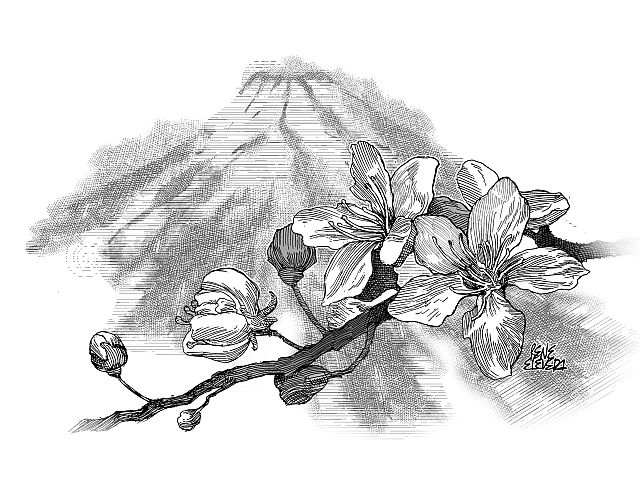 Because we stayed ni Shinjuku, Tokyo, we made sure to visit, not just the National Garden to watch the cherry blossoms, then at the last stage of flowering, but also the Tokyo Metropolitan Government Building, which was designed by Kenzo Tange, one of the most significant architects of the 20th century. Aside from its architecture (Tange designed it as a huge microchip), the building offered a panoramic view of Tokyo from the 45th floor, from which on a clear day one could see snow-capped Mt. Fuji.
Because we stayed ni Shinjuku, Tokyo, we made sure to visit, not just the National Garden to watch the cherry blossoms, then at the last stage of flowering, but also the Tokyo Metropolitan Government Building, which was designed by Kenzo Tange, one of the most significant architects of the 20th century. Aside from its architecture (Tange designed it as a huge microchip), the building offered a panoramic view of Tokyo from the 45th floor, from which on a clear day one could see snow-capped Mt. Fuji.
That day a haze hung over Tokyo and veiled Mt. Fuji, and all I could do, when the atmosphere lightened after an hour, was surmise its presence from the silhouette of the mountains that, based on the photographs, ran to the left of it.
Afterwards, the wife and I decided to walk back to our lodgings and relish the street scene and cool spring air. We passed by a Western-style coffee shop, and saw that it offered a good view of the outside, we found ourselves a seat and ordered cappuccino and danish, which were excellent, and conspired with the setting and piped-in music to make us forget that we were in Japan.
Finding ourselves sufficiently refreshed, we decided to foot it again — this time to look for a bank where we could have our dollars changed, which, because of a problem with language, required a lot of inquiries, all of them attended to by the characteristically polite and generous Japanese.
A young woman, who was standing on the sidewalk outside the door of her workplace, decided to take us to the bank herself, and was then leading us through a backstreet when I stopped in my tracks.
I realized that I had left the sling bag in the coffee shop! I was aghast, and so was the wife–my passport was in the bag, and we were scheduled to fly home the next day. I turned around and dashed the length of five blocks back to the coffee shop–probably the only one running up a street in Shinjuku at that moment, praying all the while. Lungs close to bursting, I reached the coffee shop in record time, and was overjoyed to see the bag still hanging on the back of the chair where I had sat. I looked up and thanked God for protecting my bag, and for keeping Japan free of crooks.
Memory is the moral of my monologue, in particular, the lapse thereof, now at my age of an alarmingly increasing occurrence.
In his Gospel, John writes about how in the matter Jesus did not leave anything to chance. He had told his disciples many things, sayings by which to live a meaningful life, parables that clarify the rule of God, prescriptions for attaining true happiness. How would they, of the ordinary working class, remember all of it?
Jesus told them not to worry–“I have told you this while I am with you. The Advocate, the Holy Spirit, whom the Father will send in my name, will teach you everything and remind you of all that I had told you.”
I consider the Holy Spirit as The Lord of Guidance and Memory, and often invoke Him whenever I write, to help me recall, not so much facts (in regard of which Google is a help) as truths, those that underlie purpose and direction. Indeed, with the Holy Spirit, it is less remembering than seeing, although, in a sense, to remember to see.
In Shinjuku, as I raced towards the coffee shop, despite my fear of the worst, praying gave me a sort of vision–of the bag still there, waiting for me to reclaim it–which was why I continued to run with undiminished speed towards the coffee shop.
The memory lapses remain, but I try to lessen them with alertness and circumspection. And if they happen, because anything that can happen is bound to happen, and I find myself deprived of a bridge to transport me across the river, I just surrender myself to the Holy Spirit, and allow Him to carry the car of my mind safely to the other side.
Disclaimer: The comments uploaded on this site do not necessarily represent or reflect the views of management and owner of Cebudailynews. We reserve the right to exclude comments that we deem to be inconsistent with our editorial standards.
